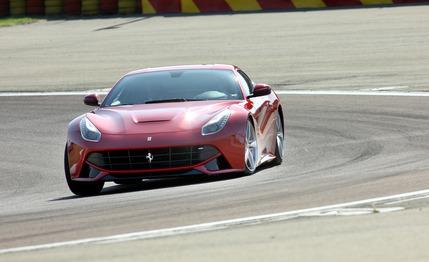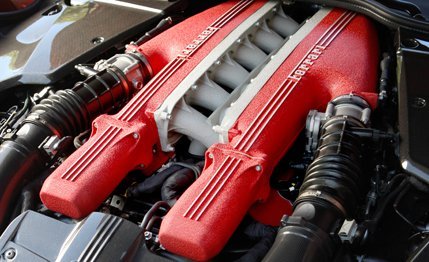 First Drive Review
First Drive Review
Within the coral-colored brick walls of Ferrari’s Maranello operations, a new supercar is starting to roll off the line. The replacement for the 599GTB Fiorano and its numerous offshoots, the new F12berlinetta will be Ferrari’s most expensive, quickest, and most powerful model when it goes on sale in the U.S. early next year at an estimated price of $330,000. Its reign as Ferrari’s flagship will be a brief one, as the Enzo replacement is expected to break cover at the Paris auto show this fall and go on sale in mid-to-late 2013.
But back to the F12. It’s a traditional Ferrari in that it seats two and has a V-12 mounted ahead of the driver. And yet tradition isn’t among the reasons Ferrari gives when asked why the F12 isn’t mid-engined or why it’s made of aluminum instead of carbon-fiber composite. As to the latter, Ferrari claims that carbon fiber is much harder to produce and get right, carbon-fiber structures usually make for difficult ingress and egress, and aluminum is easier to repair. This might sound like Ferrari trying to convince us that the world is flat, that drum brakes are better than disc brakes, that bianco is nero, but we expect the F12 to weigh in at about 3800 pounds, less than the 4085-pound Lamborghini Aventador we tested earlier this year.

My Thing Is Burlier Than Your Thing
Here’s another important number: 730. As in 730 hp, which is what the F12’s 6.3-liter V-12 makes at 8250 rpm, and that’s 39 more horses than in the big Lambo. Off the line, the Aventador’s all-wheel drive provides a better launch than the rear-drive F12 likely can muster, but the Ferrari’s superior power-to-weight ratio should give it the advantage once rolling. Closely related to the FF’s 6.3-liter V-12, the version in the F12 gets a unique block without an AWD-enabling output shaft at the front, a higher compression ratio (13.5:1), different cams, and two ingot-like resonators that hang off the front of the aluminum intake manifold to improve breathing. Revs don’t so much increase but rather spiral out of control as if someone had forgotten to install the flywheel. Fortunately, LEDs at the top of the steering wheel illuminate as the 8500-rpm redline approaches and then flash in unison when the engine reaches its 8700-rpm cutoff.
The lights aren’t merely an affectation, like hood-mounted tachometers or A-pillar-mounted gauges—they’re crucial pieces of instrumentation. Through the first few gears, you’re looking more at the leather-wrapped visors than the tachometer, as your neck works in vain to level your noggin. In fact, the V-12 seems to be hellbent on making your neck feel like an overcooked piece of spaghetti.
Indeed, the “launch” button between the seats should be marked “whiplash.” Press it, place your left foot on the brake pedal, your right foot on the accelerator, and the mighty V-12 will hold at 3000 rpm until you lift off the brake. That dumps the clutch, and the rear wheels briefly break loose before hooking up. The seven-speed dual-clutch gearbox automatically upshifts in this mode. Shifts are right now immediate, and Ferrari purposely programs the powertrain to provide an extra jolt on full-throttle upshifts. Why? Because 730 horses are apparently not dramatic enough for Ferrari engineers. We estimate that 60 mph will be a mere 3.1 seconds away, with the quarter-mile a trifling thing accomplished in 11.1. Acceleration continues until 211 mph, at which point the engine reaches its redline in seventh gear.
Fast, Yes, but Also Forgiving
There’s an old saw that says good horses don’t like bad riders. The F12 is one good horse carefully programmed to tolerate the unskilled. Electronic watchdogs monitor stability control, traction control, magnetic shock stiffness, gearbox shift speed, and rear differential to keep bad riders from becoming dead riders. Better riders can turn the small steering-wheel-mounted knob (Ferrari calls it a manettino) to reduce the amount of electronic intervention or shut it off entirely.
Although the electronic nets are onboard to protect the innocent or stupid, they aren’t responsible for the F12’s friendly manners. Ferrari worked obsessively to lower the F12’s center of gravity and to carefully package the heaviest components within its 107.1-inch wheelbase. The V-12 is perched right up against the firewall and mounted lower than in the 599, and the transaxle naturally sits between the rear wheels. A slight rearward weight bias—54 percent rides the drive wheels—ensures balanced handling, without the danger of the tail wagging the dog.